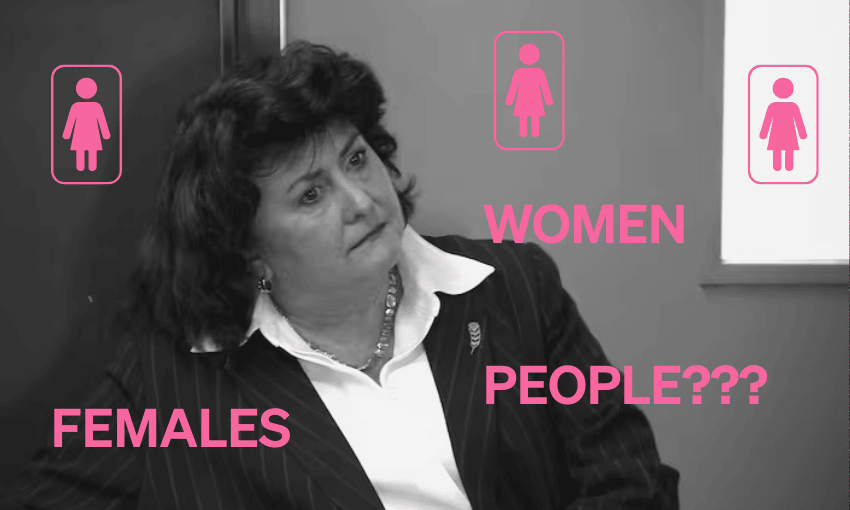Does the associate minister of health know that sex and gender are two different things? Her letter suggests no.
On March 27, associate minister of health Casey Costello sent the interim CEO of Health NZ a letter (via email) raising a serious health concern. The concern required four paragraphs of text that, on the surface, read like a fairly boring update from Costello but on a closer read, reveal a woman of the female sex deeply confused by basic medical concepts.
Let’s take it slowly.
Addressed to Dr Dale Bramley, interim chief executive, Health New Zealand.
This is a great start. Bramley’s name is spelled correctly and his job title is correct. Interestingly, the letter was sent to Bramley’s email which includes an “@TeWhatuOra” as the agency name. The government’s earlier insistence on changing Māori agency names to English to make it easier for everyone to understand has instead resulted in a much more confusing situation where people’s work email addresses don’t match their workplace name right above it.
I wonder if this will become increasingly ironic as the letter goes on.
Dear Dale
Lovely opening.
As the associate minister of health responsible for women’s health, I write to you to express concerns when referring to women in internal and public documents and communications.
Ominous first line that grabs your attention and is straight to the point. Good writing here from Costello. My immediate thought when reading this was “oh no, did someone refer to women as bitches in an email?”
As we know from the Women’s Health Strategy, we see inequity in women’s health in New Zealand for a variety of reason. These inequities are larger for many groups of women, including wāhine Māori, Pacific women, rural women and disabled women.
This is also true and it’s heartening to know that the associate minister of health is aware that different demographics have different health needs and when inequities are not addressed, it creates health outcome disparities. Confusing, then, for her government to be operating on a “need, not race” directive, particularly in the health sector, which downplays the existence of race-based inequities. Am sure Costello is looking into this and drafting up some internal letters.
It is widely accepted that there is a sex bias in the health system, meaning women often have their symptoms overlooked or minimised, resulting in delays in diagnosis.
Ah, our first basic concept, misunderstood. A sex bias suggests a bias based on, well, sex. Women having their symptoms overlooked or minimised (which does happen) is a gender bias. These are two different things. One is biological, the other social. But we still don’t fully know what this letter is about so maybe Costello will clear it up later.
Women also have sex-specific medical conditions such as endometriosis, gynaecological cancers and pregnancy are only experienced by those of the female sex.
Hmmm she’s done it again with the conflating of gender and sex. Women are certainly more likely to experience endometriosis, gynaecological cancers and pregnancy but “women” and “sex-specific” don’t really work in the same sentence. Plenty of women don’t have “female sex-specific” organs, whether through illness, congenital anomaly or – and this is what I’m assuming Costello is railing against – gender expression and dysphoria.
Costello would have gone through New Zealand’s education system back when differentiating between sex and gender was not a thing. Thankfully it is now, so young people can learn about the difference between sex and gender, including the existence of intersex and trans peo- wait, no, news just in this week: after scrapping the RSE (relationships and sexuality education) guidelines last June, the government has opened consultation on a new draft framework that includes mention of consent and sexuality but little mention of gender identities and no mention of intersex people.
As women age, they experience sex-specific issues like menopause and greater loss of bone density and higher rates of dementia than males. It is therefore important that we have clarity about the people we are referring to when talking about women’s health.
Again, concern for gender inequities in health is a good thing for the associate minister of health to raise. It is unclear which example of “unclear” language Costello is responding to here, given it’s not common to see gender-inclusive language when referring to dementia rates. What’s concerning me, however, is Costello starting a sentence with “as women age” and ending with “higher rates of dementia than males”. Women and males, the two sexgenders. Very clear, thank you.
Sex-specific language ensures that women know what health services they are entitled to and can access these easily, especially for those women with English as a second language.
“Sex-specific language” would mean only referring to patients as males or females, which I’m not sure has ever been done? Costello’s concern for women with English as a second language is nice and as someone who has “translated” more than one doctor’s appointment for my mum (who speaks fluent English as a second language), I agree that health officials could be a lot better at communicating with patients, particularly when there are different cultural and societal norms regarding pain and seeking help. I’m not sure “pregnant people” is the most pressing language to address.
Recent documents that have reached my office from the Ministry of Health have referred to women as ‘pregnant people’, ‘people with a cervix’ or ‘individuals capable of childbearing’.
Actually, they haven’t referred to women as anything. They have referred to pregnant people as “pregnant people”, people with a cervix as “people with a cervix” and individuals capable of childbearing as “individuals capable of childbearing”. This may seem semantic because it is, but if one were to expect specificity in language from anywhere, it would be from the medical sector.
Those terms above are specific. They may not be how most people talk in everyday language but they’re more medically accurate, as they should be. Lots of people, maybe even Costello, refer to “down there” as being the vagina. It’s somewhat true but if you went to a doctor, they’d (correctly) refer to the outside part as the vulva and the inside part as the vagina. And yes, I am using “outside part” and “inside part” to demonstrate accessible language.
Or, to put it another way, when I go to the doctor because I have the shits, I am broadly correct in my assessment but I would expect them to refer to it as something a bit more medically appropriate (persistent diarrhoea).
Only women and people of the female sex can get pregnant and birth a child no matter how they identify.
Unfortunately this is not true. If Costello wants to get technical about a social construct like “women” then she should also note that girls can get pregnant too. She’s also asked for clearer language but frankly “pregnant women and people of the female sex” is a lot more confusing and clunky than “pregnant people”.
My priority as the minister responsible for women’s health is to support women to live longer in better health.
Noble cause. Might I suggest not repealing smokefree laws or giving tax breaks to tobacco companies?
It is therefore reasonable to expect that women are fully aware of the services and support available to them. As such, I consider that clear language should be used in all documents and communications that refer to health issues specific to females.
Fitting to end this letter by once again conflating women and females, gender and sex. But evidently, despite not knowing this basic difference, Costello feels strongly about this language being used enough to demand that language policies be changed. And what was the policy exactly? When asked by RNZ this week, “a Health New Zealand spokesperson said the agency did not have a policy relating to the use of gender-inclusive language”.
Costello doubled down when asked to clarify her letter but added: “This does not stop Health NZ and the Ministry of Health developing communications and resources for trans and non-binary people.”
So Costello’s suggestion for “clearer” language is for Health NZ staff (with Te Whatu Ora email addresses) to instead create two separate communication strategies when referring to the same specific health needs, one which uses the very-much-not-sex-specific “women” and another that uses the more medically accurate phrasing.
In all of this, Costello never mentioned a single woman complaining about the communications or finding it hard to understand. In fact, her only reference to it was the documents she herself had received and taken issue with. Perhaps the easiest solution to this non-existent problem would be to create special communications just for Costello, so she doesn’t get further confused by the separate concepts of sex and gender.
Very clear, very efficient.


